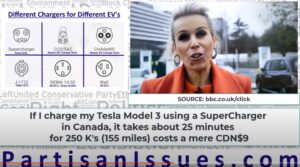

EV’s and their charging is certainly a misunderstood by many so we put together two, two minute videos to clear up the confusion. The first uses clips from a recent BBC Click episode explain how EV charging works today and second video demonstrates how home charging on a lowly 110 volt wall charger in cold weather works good enough for most people.
It is important to note that there are different charging standards and connectors in different parts of the world. For instance, China, Japan, and South Korea each have their own standard that does not work with others. To keep this topic manageable we are focusing on the standards for Europe, Canada and the United States.
In this video we explain the different chargers, rural concerns and what can effect your range:
Probably the most important point here is that EV owners keep their vehicles charged at all times because they plugin at home and often at work. The notion of “filling up the tank” every week or so does not translate well to EV’s because they are always full. This means that even rural electric vehicle owners don’t have frequent problems with running out of electricity.
It is also useful to remember that EV owners typically in the city where they have ready access to rentals for longer drives or they live in the suburbs and have an ICE (gas powered) second vehicle that they can use for long trips. Just like a pickup truck, an EV is not the best fit for all situations.
Click to Expand These Graphics
In this video we demonstrate charging in a Tesla Model 3 using the standard 110V wall charger will get you 90 Kilometers (55 miles) of charge in 12 hours at below zero temperatures. Because most people keep their EV’s charged at all times the situation we show is an extreme situation that proves the point.
This website uses cookies.